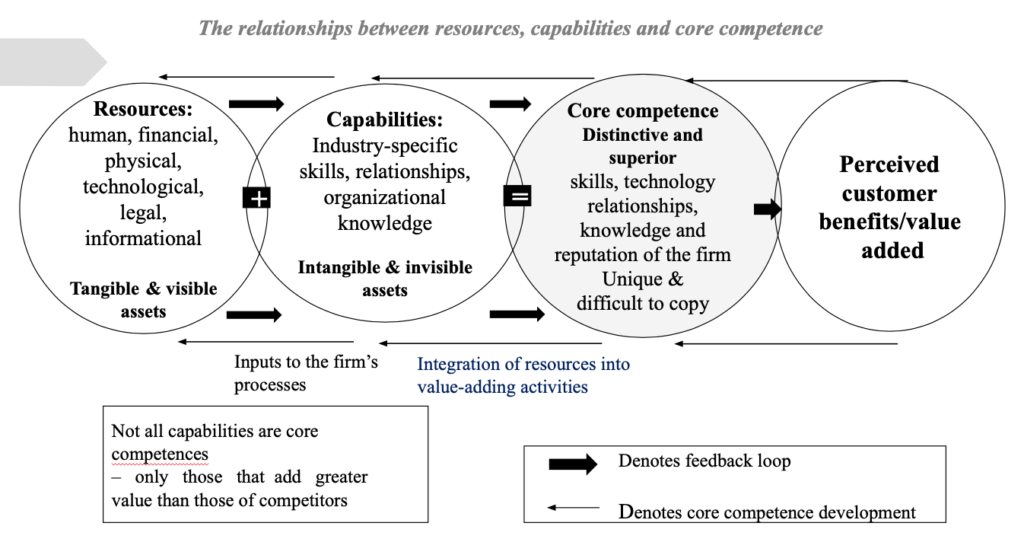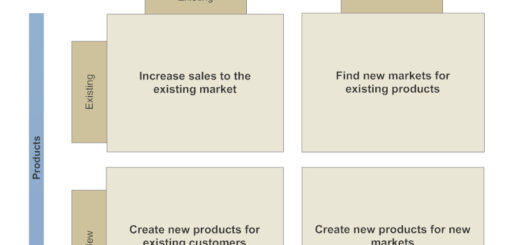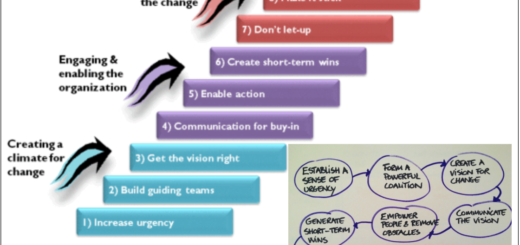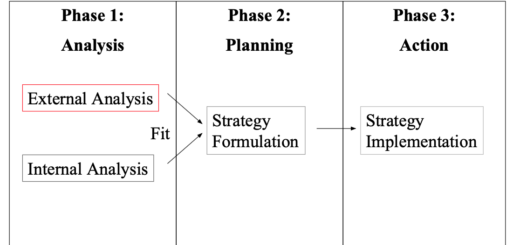Resource and Competence Analysis: Resource-Based View (RBV)
Resource and competence analysis is a method used by organizations to assess their internal capabilities and strengths in order to develop strategies that can enhance their competitive advantage. It involves identifying and evaluating the resources and competencies that an organization possesses, and understanding how they can be leveraged to achieve sustainable competitive advantage.
Resources refer to the tangible and intangible assets that an organization has at its disposal, such as financial resources, physical assets, human resources, intellectual property, and relationships with suppliers and customers. Competencies refer to the skills, knowledge, and capabilities that an organization possesses, such as its ability to innovate, its marketing and sales capabilities, and its operational efficiency.
Resource Analysis
(What the organization has)
| Physical resources | e.g. machines, buildings, production capacity |
| Financial resources | e.g. capital, cash, suppliers of money (shareholders, bankers etc) |
| Human resources | e.g. number and mix of people, skills and knowledge |
| Intellectual capital | e.g. patents, brands, customer databases |
Competence Analysis (How we use resources – what the organization is good at)
| Functional capability | e.g. marketing capability, procurement capability |
| Internal linkages / cross-functional capability | e.g. good links between sales & procurement; capability in new product development |
| External linkages (the value system) | e.g. capability in developing strong supplier or distributor relationships |
| Management capability | e.g. capability in knowledge management; capability in training and career development |
| Specialized capability | e.g. What different are we from others (3M) |
The resource and competence analysis typically involves the following steps:
- Identify the key resources and competencies of the organization: This involves identifying the resources and competencies that the organization possesses, and evaluating their value and potential for competitive advantage.
- Evaluate the competitive implications of these resources and competencies: This involves assessing the impact that these resources and competencies have on the organization’s ability to compete in the marketplace.
- Identify potential resource and competency gaps: This involves identifying areas where the organization may lack the necessary resources and competencies to compete effectively in the marketplace.
- Develop strategies to leverage the organization’s resources and competencies: This involves developing strategies that can help the organization to leverage its existing resources and competencies to achieve sustainable competitive advantage.
- Monitor and evaluate the effectiveness of the strategies: This involves monitoring the performance of the organization and evaluating the effectiveness of the strategies that have been implemented.
Resource and competence analysis is an important tool for organizations that want to achieve sustainable competitive advantage. By identifying their strengths and weaknesses and developing strategies to leverage their resources and competencies, organizations can improve their performance and achieve long-term success.
The relationships between resources, capabilities and core competence
Resources, capabilities, and core competencies are interrelated concepts that are critical to understanding an organization’s ability to achieve competitive advantage.

Resources refer to the tangible and intangible assets that an organization has at its disposal, such as financial resources, physical assets, human resources, intellectual property, and relationships with suppliers and customers. These resources can be used to create value for the organization.
Capabilities are the skills, knowledge, and abilities that an organization possesses. These capabilities are developed over time through the organization’s interactions with its resources, and they enable the organization to perform specific tasks or activities. Capabilities can be classified into different types, such as managerial, technical, or organizational.
Core competencies are the unique capabilities that give an organization a competitive advantage. They are the activities that an organization performs better than its competitors, and they are the source of its distinctive strengths. Core competencies are difficult for competitors to imitate or replicate, and they are often embedded in the organization’s culture, systems, and processes.
The relationship between resources, capabilities, and core competencies can be explained as follows:
- Resources enable capabilities: Resources provide the foundation for an organization’s capabilities. For example, having skilled and experienced employees is a resource that enables an organization to have the capability to provide excellent customer service.
- Capabilities enable core competencies: Capabilities are the building blocks of an organization’s core competencies. For example, a software company may have the capability to develop complex algorithms, which is a core competency that differentiates it from its competitors.
- Core competencies create competitive advantage: Core competencies are the unique capabilities that enable an organization to create value and achieve sustainable competitive advantage. For example, Google’s core competency in search algorithms has enabled it to dominate the online search market.
In summary, resources enable the development of capabilities, which in turn enable the development of core competencies. Core competencies are the source of an organization’s competitive advantage and are difficult for competitors to replicate. Understanding the relationship between these concepts is important for organizations that want to develop strategies to achieve sustainable competitive advantage.




